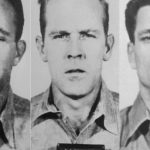Garrett Graff
Garrett Graff is a political writer. Throughout his career, he has covered a lot of touch subjects, including the War on Terror and the 2008 U.S. presidential election. When a friend gave him something peculiar, it piqued his interest. What a friend gave him was a government ID from someone in the intelligence sector of the government. His friend figured since he covered political issues that he could get the ID back to its rightful owner. He also mentioned that it was found on the floor of a parking garage.
Something Peculiar
When Garrett looked at the ID, he noticed something strange on the back of it. There were step-by-step driving instructions. Being the curious journalist that he was, he used Google Maps to find where the directions led. What he found strange was that the directions led to a mountain peak just over 70 miles outside of Washington D.C. He got in his car and drove out there. He found himself at a peak known as Raven Rock. The directions took him to the face of the mountain, and that was it.
Strange Discoveries
While Garrett was driving out to the location, he noticed massive concrete bunker doors. He also saw a guard shack, a chain-link fence, and a huge set of bunker doors beyond the fence. There were also signs posted to warn people that it was a restricted area. He had no idea what the facility was and what it was used for. He couldn’t find the facility of any map. The reporter and historian in him had him freaking out, and determined to figure out what he had stumbled upon.
Site R
After doing some research, Garrett realized that what he found was known as “Site R,” and it was a nuclear fallout shelter. He did more research and found plenty of information about the Unites State government’s nuclear contingency plan. Some of it he found comforting, some was horrifying, but overall, everything he learned was fascinating.
The Truman Administration
In 1951, as the Cold War with the Soviet Union was heating up, the Truman Administration sanctioned the construction of the bunker. They hired the same people who created the New York City subway tunnels to handle the job. A laborer named Gene Bowman was one of the men on the crew. He was paid $1.35 per hour to create a tunnel in the granite of Raven Rock. He and his crew were told that they were building a tunnel. They didn’t think too much about it. The finished product looked to be much more than a tunnel.
Free-Standing City
Garrett describes the Raven Rock Complex as a free-standing city built into the side of a mountain. Site R was designed to be a backup Pentagon. The doors to Site R had doors that could withstand a 34-ton blast, which not even a nuclear bomb could penetrate. Beyond the doors were 100,00-square feet of office space so that the military officials would have enough room to set up and operate. There are also infirmaries, cafeterias, and residential areas for up to 1,400 of the United States’ VIPs to live.
No Room For Spouses
Inside the bunker, there was room for the President, the cabinet, government officials, and military personnel. The only problem was that there was no room for spouses. This led to a famous exchange between the Supreme Court Justice at the time, Earl Warren, and another top official. When Earl was handed an ID badge for access to Raven Rock, he noticed that there wasn’t one for his wife. When he was told that she wouldn’t be allowed in, he handed his ID badge back and told the official to give it to someone else. If his wife couldn’t go, neither was he.
A Major Setup
Raven Rock wasn’t just a place for the highest members of government to wait out the end of the world. Garrett discovered that the officials set up operation plans for every federal branch, including the IRS and the post office. The government even put a post-bomb plan in place for the IRS. They had a way to tax damaged property instead of vaporized property. They weren’t going to let Americans off the hook for their taxes just because the world was coming to an end. Also, they had a plan for people to get money to pay their taxes after a nuclear blast. Officials stashed away $2 bills in another shelter that they would redistribute as currency.
Essential Jobs
When the facility was created, so were jobs for various federal departments. The Parks Department was in charge of setting up refugee camps. The Department of Agriculture was in charge of dividing up the rations. The post office was in charge of finding out who died in the blast. Everyone had a job to pull things together after a nuclear attack.
Fully Manned
When Raven Rock was complete, the Cold War was a serious threat, as was a nuclear attack. Because of this, Raven Rock was operated 24 hours a day, 7 days a week. Things calmed down, and in 1992, this ended. Operations weren’t picked up again until after the 9/11 attacks. Ever since then, the facility has been staffed 24/7 again.
Uncovering More
The ID card that Garrett received brought him to Raven Rock, but his research helped him determine that there were a half dozen more doomsday shelters, and they all have the same function and design. There is one under the Greenbrier Resort in West Virginia.
Cheyenne Mountain
In the Cheyenne Mountains near Colorado Springs, there is another hidden doomsday bunker similar to Raven Rock. It was built in the ’50s, and it served as the command post responsible for defending the U.S. and Canada from air attacks. This facility contained a reservoir of water and fuel. There were also doctor’s offices, gyms, and even a Subway sandwich shop. If there were a nuclear attack, the sandwich artist working that day would earn a place with the elite chosen to survive.
Uncovering Something Unsettling
During his research, Garrett learned something unsettling about the end of the world. If there were an attack, and the government was restarted, nobody knew what this would mean for America. In his research, Garrett learned that the civilian population would have for fed for themselves for weeks or months. Meanwhile, the senior government officials would be taken out to these doomsday bunkers. The government only cares about preserving artifacts and the system of government rather than caring about the people. He learned that the new America would consist of top government officials and important documents like the Declaration of Independence.
Garrett’s Book
Garrett wanted the public to know about what was going on, so he wrote a book called, “Raven Rock: The Story of the U.S. Government’s Secret Plan to Save Itself-While the Rest Of Us Die.” It’s incredible that all this information and a book came from a lost ID badge. His leaked photos expose covert program the government has been concealing from the public.
The End
Now that we know that the government won’t care about American citizens if there is a nuclear blast, what can we do? Some say that they will accept it and hope for the best. Others have been making plans for decades for the end of the world. One of these people is Jay Hay.
Jay Hay
Jay Hay was a former marine and the co-founder of the Celestial Seasonings tea brand. He also owned lucrative real estate all over the country. He was always worried about a nuclear attack. When tensions between the U.S. and the Soviet Union shot back up in the ’80s, both sides were stockpiling weapons and mobilizing troops all over the world. This terrified Jay. He was worried that the government couldn’t protect its citizens. He decided to do something to save himself.
The Ozark Mountains
In 1983, he bought a 240-acre piece of land in the Ozark Mountains in Arkansas for $146,000. He planned to build a fallout shelter in a gigantic limestone cave on his new property, and he began construction. When the tensions between the U.S. and the Soviet Union began to improve, he realized that he wouldn’t need a fallout shelter. It was already half-built, so he had to find something else to do with the property. It was then that he came up with a new plan. And it took a few years of intense construction and furnishing, and finally, the Beckham Creek Cave Lodge was born. What was once going to be a bomb shelter is now a subterranean, high-end hotel.
The Hotel
The interior of the hotel is absolutely incredible. There are four bedrooms in the cave, and to stay in one of them, it costs $1,600 per night. There are even showers built right into the cave. The main area has a 75-inch LED TV mounted on the limestone walls. It also has a thermal heating system, which will keep you warm regardless of the cold weather outside. It also contains a state-of-the-art kitchen, where something other than canned goods can be prepared.
Enjoying the Outdoors
Guests aren’t just confined to the caves during their stay. The views outside are incredible, and hiking the Ozarks is a great way to spend a day. There is plenty of wildlife around for guests to see. The inside of the hotel and the outside views are all incredible.
Safety During a Nuclear War
If there is the threat of a nuclear war, the hotel can seal off all of the openings to the cave with concrete blocks, which will keep the guests inside safe if the worst were to happen. Jay also installed a helipad at the hotel. This would make it possible for him to get there quickly if there is a nuclear threat. It also makes it possible for guests to take a helicopter to the hotel, making the trip there much faster.
On the Market
If you have always dreamed of owning your own fallout shelter that doubles as a private retreat, you are in luck. Recently, the cave was listed on the market for $2.75 million. If you did have the money to buy the property, you could be sure that you will be safe if the unthinkable happens. It also makes for a great vacation home, and you won’t need to worry about noise because there is nobody around for miles.
How Many?
With the nuclear fallout shelters designed by the government, and Jay’s hotel/fallout shelter, it makes you wonder how many more civilians have fallout shelter of their own. A man in California bought a home only to find that there was a perfectly preserved fallout shelter buried 15 feet below his backyard. The shelter was built in 1961, and there was a company that was advertising their “affordable” fallout shelter. Back in the ’50s and ’60s, people were terrified that a nuclear bomb would hit the U.S., and they wanted to be prepared.
Keep It a Secret
Most people who have fallout shelters or bunkers today often keep it a secret. If you had a bunker or a fallout shelter and there is a nuclear warning, the last thing you would want is for everyone in town to show up in front of your bunker trying to get in. How do you turn friends, family, and neighbors away if the world is about to end? The people who own these types of shelters call themselves “doomsday preppers,” and most have dedicated many years of their lives to preparing for the end of time. These people stockpile food, water, clothing, fuel, and other essentials. Like the government elite, doomsday preppers will still be around when the end comes. When the end is near, just don’t try to show up at Raven Rock. Unless you are a VIP member of the government, you aren’t going to get in.


